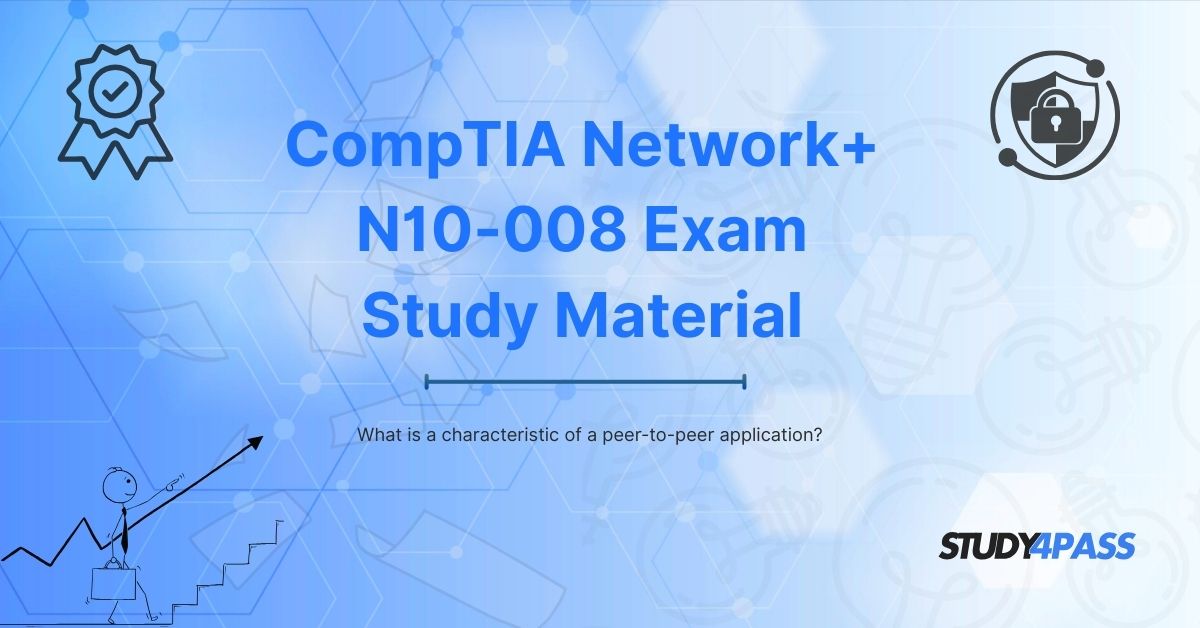Introduction
Peer-to-peer (P2P) applications have revolutionized the way data is shared and processed across networks. Unlike traditional client-server models, P2P networks distribute tasks among all connected devices (peers), enhancing efficiency and reducing dependency on centralized servers. Understanding P2P applications is crucial for the CompTIA Network+ (N10-008) certification, as it covers key networking concepts, including network models, protocols, and security considerations.
This article explores the characteristics of P2P applications, their advantages, disadvantages, and real-world examples. Additionally, we’ll discuss how Study4Pass provides excellent CompTIA Network+ study materials to help you ace your certification exam.
What is a Peer-to-Peer (P2P) Application?
A peer-to-peer (P2P) application is a decentralized networking model where each device (peer) can function as both a client and a server. Unlike centralized systems where a single server handles requests, P2P networks distribute workloads across multiple nodes, improving scalability and fault tolerance.
Key Features of P2P Applications
- Decentralized Architecture – No central server; peers communicate directly.
- Resource Sharing – Peers share bandwidth, storage, and processing power.
- Scalability – More peers enhance network capacity.
- Redundancy & Fault Tolerance – Data is replicated across multiple nodes.
- Self-Organizing – Peers dynamically join or leave the network.
Characteristics of Peer-to-Peer Applications
A. Decentralized Control
- P2P networks operate without a central authority.
- Each peer can initiate or fulfill requests independently.
- Example: BitTorrent (file-sharing without a central server).
B. Distributed Data Storage
- Files are stored across multiple peers rather than a single server.
- Enhances availability and reliability.
- Example: IPFS (InterPlanetary File System).
C. Dynamic Peer Participation
- Peers can join or leave the network at any time.
- The network automatically adjusts to changes (self-healing).
D. Load Balancing
- Workloads are distributed among peers, preventing bottlenecks.
- Improves performance and efficiency.
E. Resilience to Failures
- If one peer fails, others continue operating.
- No single point of failure (unlike client-server models).
F. Security & Anonymity Challenges
- P2P networks may be vulnerable to malware and unauthorized access.
- Some P2P apps (e.g., Tor) enhance anonymity but can be exploited.
Advantages of P2P Applications
- Cost-Effective – No need for expensive servers.
- High Scalability – More peers = better performance.
- Fault Tolerance – No single point of failure.
- Efficient Resource Utilization – Uses idle bandwidth/storage.
Disadvantages of P2P Applications
- Security Risks – Vulnerable to malware and attacks.
- Unpredictable Performance – Depends on peer availability.
- Legal & Ethical Concerns – Used for illegal file sharing (e.g., pirated content).
Real-World Examples of P2P Applications
- BitTorrent – Decentralized file sharing.
- Bitcoin & Blockchain – Decentralized cryptocurrency transactions.
- Skype (Early Versions) – Used P2P for voice/video calls.
- Freenet – Anonymous P2P communication.
P2P in CompTIA Network+ (N10-008) Certification
The CompTIA Network+ N10-008 exam covers P2P concepts under:
- Network Models (Client-Server vs. P2P)
- Network Services & Applications
- Security Implications of P2P
Why Understanding P2P is Important?
- Helps in designing efficient networks.
- Essential for troubleshooting network issues.
- Critical for cybersecurity awareness.
How Study4Pass Helps You Pass CompTIA Network+
Preparing for the CompTIA Network+ exam requires high-quality study materials. Study4Pass offers:
- Comprehensive N10-008 Study Guides – Covers all exam objectives.
- Practice Tests & Simulations – Mimics real exam scenarios.
- Expert Explanations – Simplifies complex networking topics.
- Up-to-Date Content – Aligned with the latest CompTIA standards.
Why Choose Study4Pass?
- Affordable & High-Quality Material
- Interactive Learning Tools
- Pass Guarantee – Boosts confidence before the exam.
Visit Study4Pass today and ace your CompTIA Network+ certification!
Conclusion
Peer-to-peer applications play a vital role in modern networking, offering scalability, fault tolerance, and efficiency. However, they also pose security and legal challenges. For CompTIA Network+ (N10-008) aspirants, mastering P2P concepts is essential.
By leveraging Study4Pass top-tier study materials, you can gain a deep understanding of P2P networks and other critical exam topics, ensuring certification success.
Special Discount: Offer Valid For Limited Time “N10-008 Exam Material”
Actual Exam Questions For CompTIA's N10-008 Certification
Sample Questions For CompTIA N10-008 Practice Exam
1. Which of the following is a characteristic of a peer-to-peer (P2P) application?
a) Requires a centralized server for all communications
b) Allows devices to function as both clients and servers
c) Uses only wired connections for data transfer
d) Operates exclusively in offline mode
2. In a peer-to-peer network, what role do individual nodes typically play?
a) Only consumers of resources
b) Only providers of resources
c) Both consumers and providers of resources
d) Dependent on a mainframe computer
3. Which of the following best describes a peer-to-peer application?
a) A system where all data must pass through a central authority
b) A decentralized network where peers share resources directly
c) A network that relies solely on cloud-based servers
d) A hierarchical structure with a master-slave relationship
4. What is a key advantage of peer-to-peer applications?
a) Complete reliance on a single server for stability
b) Reduced scalability due to direct connections
c) Elimination of a single point of failure
d) Higher cost due to centralized infrastructure
5. Which of the following is an example of a peer-to-peer application?
a) A traditional email server like Microsoft Exchange
b) A file-sharing system like BitTorrent
c) A cloud storage service like Google Drive
d) A centralized database management system


